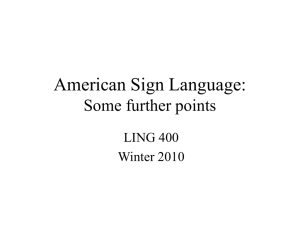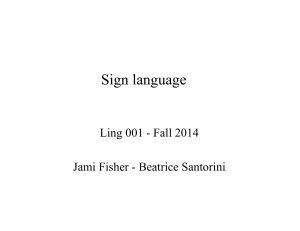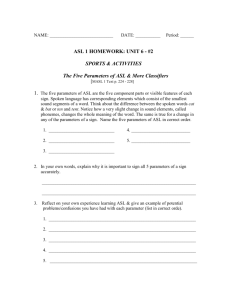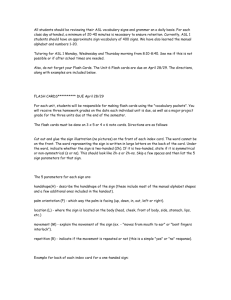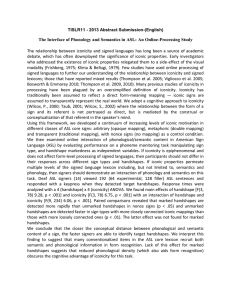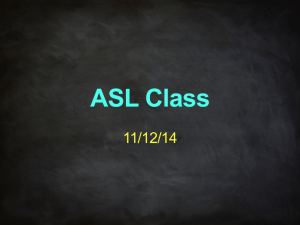American Sign Language
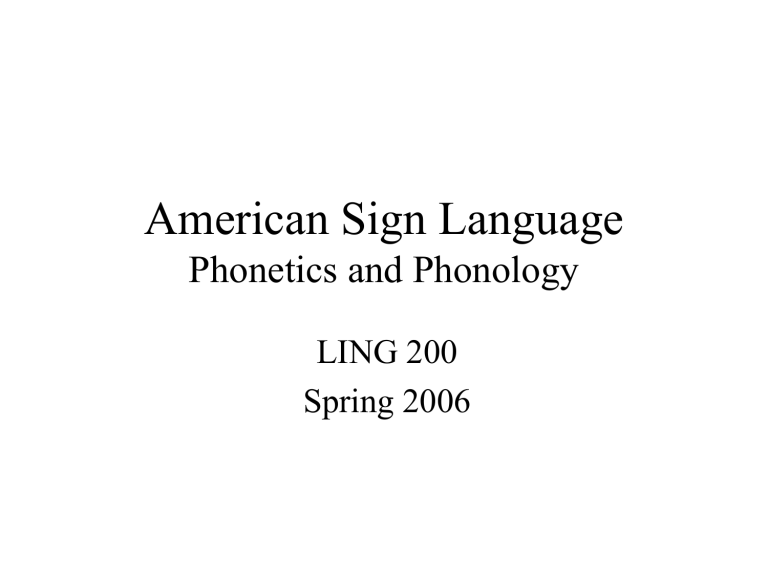
American Sign Language
Phonetics and Phonology
LING 200
Spring 2006
Overview
• Sign languages: general characteristics
• American Sign Language and other sign languages
• Iconicity vs. arbitrariness
• Phonetic dimensions of ASL
• Iconicity vs. phonology
Sign languages in Ethnologue
•
Ethnologue lists 121 sign languages
(incomplete list)
(http://www.ethnologue.com/show_family.a
sp?subid=90008)
What is a sign?
• Sign in sign languages word in spoken languages
• Traditionally, signs are referred to (in English) by translation (gloss) of sign
• Translation conventionally given in capital letters
– CAT
American Sign Language
• The preferred language of the Deaf community of the US and Canada
– deaf vs. Deaf
• Has dialects
– rural south ASL is most divergent
• Usually learned from
– peers at residential schools
– adult members of the Deaf community
Characteristics of sign languages
• Human languages (including ASL) compared to some other communication systems
• A clip from Clayton Valli and Ceil Lucas,
Linguistics of American Sign Language. 2 nd ed. (The signer is Clayton Valli.)
Sign language families
• Signed languages are not signed versions of spoken languages
• The sign language of an area does not belong to the same family of languages as the spoken language of that area
• Signed languages can be grouped into historical families
• Families of spoken languages families of sign languages
American Sign Language and related languages
Old Kentish SL
MVSL Old ASL Old French Sign Language
ASL French SL ROISL Span SL NGT QSL
ASL = American Sign Language
MVSL = Martha’s Vineyard Sign Language
NGT = Dutch Sign Language
ROISL = Republic of Ireland Sign Language
QSL = Quebec Sign Language
Old French SL: attested 300 years ago
Other families of sign languages
British SL New Zealand SL Australian SL
Iconicity in spoken language
• Sound meaning
– arbitrary, non-iconic
– [h E r] ‘hair’ vs. ‘hare’
• Onomatopoeia (sound imitating environment)
– to neigh, meow, mew, bark, woof, moo, oink, etc.
– But cross-linguistic differences:
• [b A rk] ‘bark’
• Tsek’ene [y A ht h ic
], Witsuwit’en [y ts h E ] ‘it’s barking’
Iconicity in signed languages
Is sign language pantomime?
The iconicity issue
EYE BLACK
Historically iconic signs
MILK
COFFEE
Differences between sign languages
• TREE in ASL vs.
Chinese SL
• BREAD in ASL vs.
French SL
Phonetic dimensions of ASL
• Signs are not random combinations of gestures
• Signs differ along certain phonetic parameters
Phonetic dimensions of ASL
• Parameters
– handshape
– location
– movement
– orientation
– number of hands
– non-manual expression
•
Values of parameters realized simultaneously
• In some signs, a parameter may have two or more values (sequenced)
One- vs. two-handed signs
• Some signs articulated with one hand only
– strong or dominant hand
• Some signs articulated with two hands
– weak or non-dominant hand is restricted
Handshape
Some different handshapes (different from those listed on p. 266)
TEN FLY
Handshape
MOTHER
(5 hand)
BOY (2 variants)
Signs which change handshape
UNDERSTAND DIVORCED
HOW MANY?
http://commtechlab.msu.edu
/sites/aslweb/browser.htm
Minimal pairs for handshape
PEOPLE BICYCLE
Minimal pairs for handshape
• SEATTLE vs. NEUTRAL vs. TWIN
• NUMBER vs. INTERPRET
• DORM vs. DEAF
• RED vs. CUTE
Orientation
• Palm of hand faces some direction
ACROSS
Sign with change in orientation
DEATH also COMMUNITY, CLASS
BOOK
Near-minimal pairs for orientation vs. MY
YOUR
CHILD
Minimal pair for orientation
NAME
SIT
Minimal pair for orientation vs. TRAIN
SHORT
SOCK vs. STAR
on parts of face
Location
FUNNY
WATER
DOG on leg or arm
Location
HOSPITAL
Location neutral space weak hand
CAR STAND
Signs with change in location
DEAF
FUN
Signs with change in location
KING
YESTERDAY
BLUE
Minimal pair for location
SUMMER
DRY
Near-minimal pair for location
APPLE ONION
Movement
• Some different types of movement
– hooked - linear
PERCENT SEPARATE(D)
nodding
Movement looping
WASHINGTON (STATE)
YES
“Local” or “internal” movement movement at elbow or wrist joint, and/or finger wiggling
COLOR
WHERE?
Minimal pair for movement
FLY AIRPLANE
More minimal pairs for movement
• SIT vs. CHAIR
• WINDOW vs. OPEN-WINDOW
• MACHINE vs. ROOMMATE vs. GRAY vs.
AMERICA
• PAPER vs. SCHOOL
• RIDE vs. RIDE-HORSE
• OLD vs. ORANGE
• TURN-AROUND vs. SINGLE
• BROWN vs. BEER
Near-minimal pair for movement
NEWSPAPER
Number of hands
• Some one-handed signs
MOTHER FATHER
Number of hands
• Some two-handed signs
HERE BICYCLE
Two-handed signs
DOOR
COOL (v.)
Minimal pairs for one- vs. twohanded signs vs. PURPLE
PARTY PEOPLE
Minimal pair for one- vs. twohanded
TEACH
BOY
Non-manual expressions
•Signs articulated which include non-manual expression
•OH-I-SEE
•PROSTITUTE
Body shift/lean movement of body part other than hands
YES BED
Minimal pair for non-manual expression
NOT-YET
LATE
Minimal pairs for non-manual expressions
HERE
WHAT?
Sign language transcription
• Different transcription systems
– Sign Writing: www.signwriting.org
– Hamburg Sign Language Notation System
(HamNoSys): http://www.sign-lang.unihamburg.de/projects/HamNoSys.html
• Unlike transcription of spoken languages, none in widespread use
Iconicity vs. phonology
‘For sign languages, a phonology systematically separates the set of gestures which may represent meanings in a given sign language from the entire range of gestures which may be produced by the human body...iconicity is inversely related to phonological…structure. This is because an iconic relation is a direct analog mapping between some aspect(s) of a sign and some aspect(s) of its referent, with no regard to the way other signs are made. For a phonology, however, relations between the form of signs is everything.’ (Battison 1974:2)
The Symmetry Condition
• A restriction on two-handed signs
(first identified by Battison 1974)
– ‘if both hands move independently during a given two-handed sign...then the specifications for handshape and movement must be identical and the orientations must be either identical or polar opposites (reciprocals).
Locations...must also be specifed either as symmetrical or as polar opposites.’
• both hands move, handshapes identical, opposite orientations, symmetrical locations: DIE/DEAD/DEATH
If handshapes not identical
• If handshapes not identical, both hands cannot move
– Different handshapes, only one hand moves:
DRAW
Phonology vs. iconicity
• Phonology: specification of a template which all signs (or spoken language units) must conform to in a particular language
– ASL phonological template includes Symmetry
Condition (among other restrictions)
– signs resemble other signs in some arbitrary way
• Iconicity: a sign (or spoken language unit) should resemble what it refers to
– not other signs

